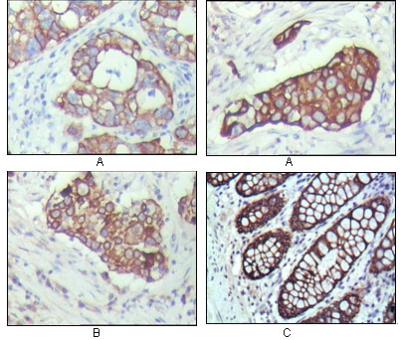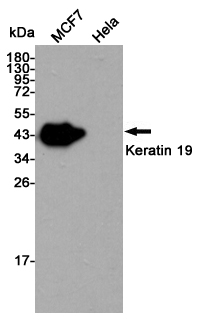-
Product Name
Anti-Cytokeratin 19 (5F3) Mouse antibody
- Documents
-
Description
Cytokeratin 19 (5F3) Mouse monoclonal antibody
-
Tested applications
WB, IHC-P
-
Species reactivity
Human
-
Isotype
Mouse IgG1
-
Preparation
Antigen: Purified recombinant fragment of Cytokeratin 19 (aa80-400) expressed in E. Coli.
-
Clonality
Monoclonal
-
Formulation
Ascitic fluid containing 0.03% sodium azide.
-
Storage instructions
Store at 4°C short term. Store at -20°C long term. Avoid freeze / thaw cycle.
-
Applications
WB: 1/500 - 1/2000
IHC: 1/200 - 1/1000
ELISA: 1/10000
-
Validations

Immunohistochemical analysis of paraffin-embedded human breast carcinoma(A), lung cancer(B) and normal colon tissue(C), showing cytoplasmic localization with DAB staining using KRT19 mouse mAb.

Western blot detection of Keratin 19 in MCF7 and Hela cell lysates using Keratin 19 mouse mAb (1:5000 diluted).As expected, the protein is absent in Hela cells.Predicted band size:44KDa.Observed band size:40KDa.
-
Background
Swiss-Prot Acc.P08727.Cytokeratin 19, also known as KRT19, CK19, CK19, K1CS, MGC15366. Entrez Protein NP_002267. It is a member of the keratin family. The keratins are intermediate filament proteins responsible for the structural integrity of epithelial cells and are subdivided into cytokeratins and hair keratins. The type I cytokeratins consist of acidic proteins which are arranged in pairs of heterotypic keratin chains. Unlike its related family members, this smallest known acidic cytokeratin is not paired with a basic cytokeratin in epithelial cells. It is specifically expressed in the periderm, the transiently superficial layer that envelopes the developing epidermis.
Related Products / Services
Please note: All products are "FOR RESEARCH USE ONLY AND ARE NOT INTENDED FOR DIAGNOSTIC OR THERAPEUTIC USE"
